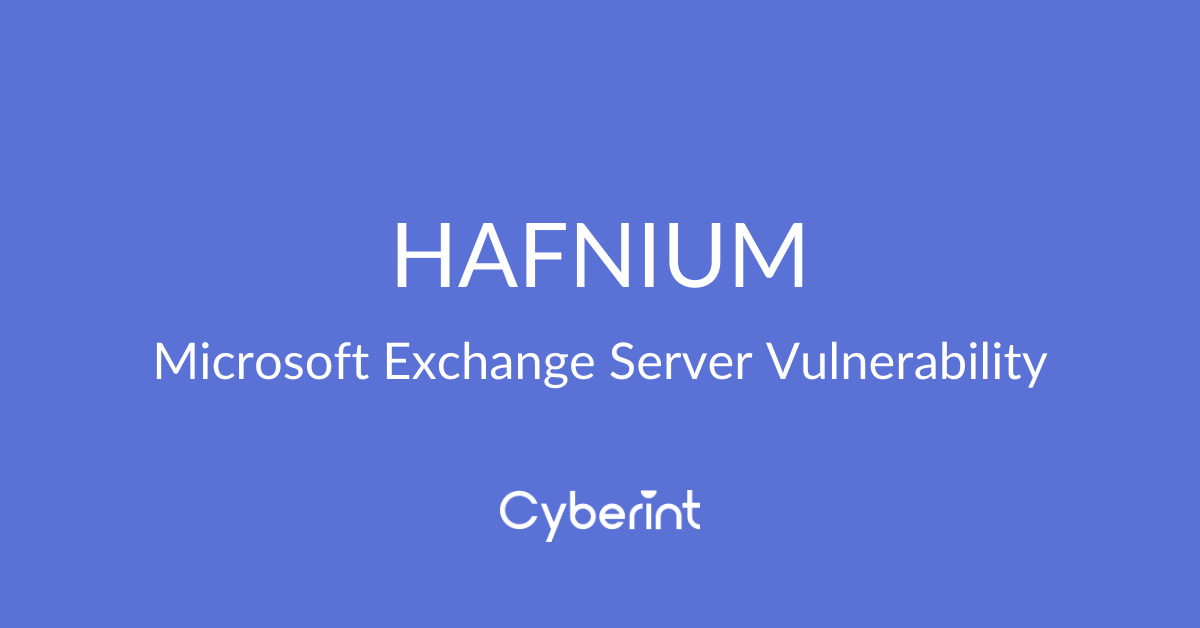


Microsoft have recently shared [1][2] details of active threats targeting on-premise Microsoft Exchange servers worldwide by exploiting chained vulnerabilities that lead to the threat actor gaining full control of the affected email server.
Vulnerable Microsoft Exchange servers are reportedly attacked via an initial untrusted connection being made to an exposed ‘Outlook on the Web’/’Outlook Web Access’ instance, typically accessible via the path /owa/ on TCP port 443, and then four chained vulnerabilities being exploited:
SYSTEM privileges.Whilst CVE-2021-26857, CVE-2021-26858 and CVE-2021-27065 require administrative privileges to exploit, chaining these with CVE-2021-26855 or obtained credentials through some other means would allow exploitation.
These vulnerabilities have been identified as exploited through the use of ‘in-the-wild’ zero-day exploits (‘0days’) in attacks believed to have been orchestrated by the APT group dubbed ‘HAFNIUM’. The Microsoft Threat Intelligence Center (MSTIC) attributes this activity to the group with high confidence and, based on observed tactics, techniques and procedures (TTP) assesses the group as being a Chinese-nexus nation state threat actor.
Successful attacks against vulnerable on-premise Microsoft Exchange servers could allow a threat actor to gain full control of the server including the ability to execute additional payloads, access user email accounts and redirect emails to external entities. Furthermore, it is possible that a threat actor could use a compromised host to move laterally across a victim network, pivoting internally for more impactful persistency, as well as install additional threats such as a ‘web-shell’ to provide backdoor access.
Reports suggest that malicious campaigns exploiting the initial SSRF vulnerability have been active since at least 3 January 2021 with multiple semi-functioning proof-of-concept (PoC) exploits being available as of 11 March 2021.
Furthermore, as of 12 March 2021, reports suggest that threat actors are taking advantage of these vulnerabilities in order to deploy a ransomware payload called ‘DearCry’ on affected Microsoft Exchange servers. As such, those that have not already taken action should do so now as a matter of urgency.
Finally, readers are reminded that these vulnerabilities only impact on-premise installations of Microsoft Exchange and therefore Microsoft Exchange Online or Office 365 (cloud services) are not believed to be affected.
The impact of these chained vulnerabilities is deemed CRITICAL and is reported as affecting the following Microsoft Exchange versions:
Additionally, the following ‘end-of-life’ products are potentially vulnerable:
As exploits for these vulnerabilities are now publicly available, the number of vulnerable Exchange servers being attacked is estimated by various sources to be in the region of one thousand servers per second.
Dubbed ‘ProxyLogin’, CVE-2021-26855 is exploited by crafting a HTTP request that performs a server-side request forgery (SSRF) by modified the HTTP Cookie header to impersonate a request as originating from the Exchange server itself, localhost (Figure 1).
Figure 1 – Example ‘ProxyLogon’ HTTP request
This in turn bypasses the authentication protocols, such as Kerberos, and allows a threat actor to perform high-privilege actions without the need for valid credentials.
In order to maintain access, and presumably for ease of management, HAFNIUM have taken to installing web-shells on compromised servers. Web-shells are developed using various web technologies, in this case ASP and HTML, to provide an easy to use interface with common functionality including remote file and shell access to allow both the download and upload of data as well as the execution of various processes.
Reported post-exploitation activity, following the Microsoft Exchange server compromise and the potential installation of a web-shell, includes the use of legitimate processes and tools to gather additional intelligence:
prcodump64.exe, used to dump the process memory for the Local Security Authority Subsystem Service (LSASS), presumably in an attempt to gather credentials.Additionally it is reported that ‘offline address books’ have been downloaded from compromised hosts which would likely prove useful for intelligence and reconnaissance efforts against the victim organization.
<Exhange_Installation_Path>\Logging\ECP\Server\ and specifically the string S:CMD=Set-OabVirtualDirectory.ExternalUrl='.Contact us to learn more about Threat Intelligence by the Argos™ Digital Risk Protection platform
[1] https://www.microsoft.com/security/blog/2021/03/02/hafnium-targeting-exchange-servers/
[4] https://github.com/microsoft/CSS-Exchange/tree/main/Security
Fill in your business email to start


